These glass models show nanostructures in new metals revealed at the atomic scale by researchers at the University of Sydney. The 3-D atomic-scale data was generated on an atom probe microscope by Microscopy Australia researchers at the University of Sydney.
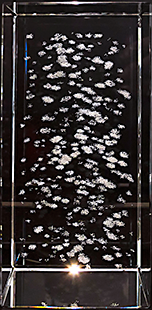
Each dot shows the position of a single atom of titanium, vanadium or carbon. This steel was designed so that clusters form amongst the iron atoms during production, making it forty percent stronger than the steel previously used in these applications. Getting clusters to form within individual steel crystals takes great expertise.
Researchers: Dr Homer Yen and Prof. Simon Ringer. Scale: the sample is 60 nm wide.
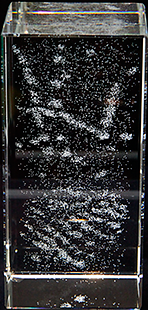
Each dot shows the position of a single atom of niobium or nitrogen. The niobium nitride clusters form at the boundaries between individual steel crystals during the manufacturing process, significantly increasing strength and hardness while keeping its formability.
Researchers: Sachin Shrestha and A/Prof. Julie Cairney in collaboration with BlueScope Steel. Scale: the sample is 65 nm wide.
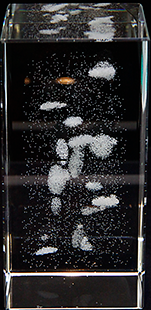
Each dot shows the position of a single atom of copper or tin. Tin tends to be found in the smaller spherical clusters and copper in the larger plates. These structures develop as the alloy is heated to 200°C.
Researchers: Andrew Breen and Dr Tomoyuki Honma. Scale: the sample is 68 nm wide.
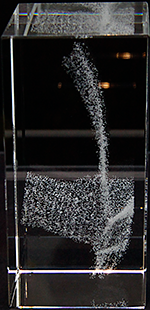
Each dot shows the position of a single atom of gallium. The structures are created by infusing the crystal boundaries with gallium atoms from a focused ion beam. This highlights the arrangement of boundaries in this extremely thin nanocrystalline aluminium film and enables researchers to learn about the strength and mechanical properties of the material.
Researchers: Peter Felfer and A/Prof. Julie Cairney. Scale: the sample is 50 nm wide.
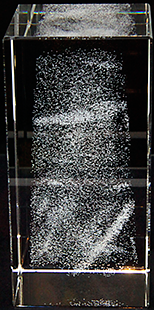
Each dot shows the position of a single atom of aluminium, copper or lithium. The lithium makes the alloy lighter. Intersecting groups of atoms called plates add stiffness, stopping the metal from bending under pressure. The silver and magnesium help the plates to form even though they are not present in these structures.
Researchers: Vicente Araullo-Peters and A/Prof. Julie Cairney. Scale: the sample is 45 nm wide.
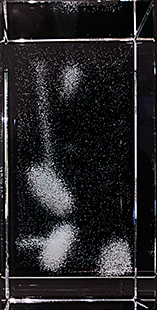
Each dot in the round, flat ‘plates’ shows the position of a single atom of silver. Silicon, copper and magnesium atoms have accumulated into rod-shaped groups. The connection between the plates and rods is unusual and forms as the alloy ages.
Researchers: Dr Gang Sha and Prof. Simon Ringer. Scale: the sample is 45 nm wide.
Data was prepared for production with the help of Dr Matt Foley and the glass models produced by The Engraving Crew. Model photography by Peter Murphy and Deirdre Molloy.